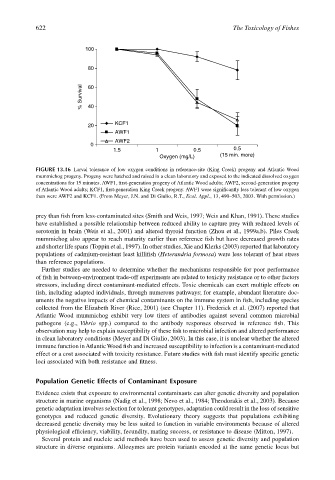Page 642 - The Toxicology of Fishes
P. 642
622 The Toxicology of Fishes
100
80
% Survival 60
40
KCF1
20
AWF1
AWF2
0
1.5 1 0.5 0.5
Oxygen (mg/L) (15 min. more)
FIGURE 13.16 Larval tolerance of low oxygen conditions in reference-site (King Creek) progeny and Atlantic Wood
mummichog progeny. Progeny were hatched and raised in a clean laboratory and exposed to the indicated dissolved oxygen
concentrations for 15 minutes. AWF1, first-generation progeny of Atlantic Wood adults; AWF2, second-generation progeny
of Atlantic Wood adults; KCF1, first-generation King Creek progeny. AWF1 were significantly less tolerant of low oxygen
than were AWF2 and KCF1. (From Meyer, J.N. and Di Giulio, R.T., Ecol. Appl., 13, 490–503, 2003. With permission.)
prey than fish from less-contaminated sites (Smith and Weis, 1997; Weis and Khan, 1991). These studies
have established a possible relationship between reduced ability to capture prey with reduced levels of
serotonin in brain (Weis et al., 2001) and altered thyroid function (Zhou et al., 1999a,b). Piles Creek
mummichog also appear to reach maturity earlier than reference fish but have decreased growth rates
and shorter life spans (Toppin et al., 1997). In other studies, Xie and Klerks (2003) reported that laboratory
populations of cadmium-resistant least killifish (Heterandria formosa) were less tolerant of heat stress
than reference populations.
Further studies are needed to determine whether the mechanisms responsible for poor performance
of fish in between-environment trade-off experiments are related to toxicity resistance or to other factors
stressors, including direct contaminant-mediated effects. Toxic chemicals can exert multiple effects on
fish, including adapted individuals, through numerous pathways; for example, abundant literature doc-
uments the negative impacts of chemical contaminants on the immune system in fish, including species
collected from the Elizabeth River (Rice, 2001) (see Chapter 11). Frederick et al. (2007) reported that
Atlantic Wood mummichog exhibit very low titers of antibodies against several common microbial
pathogens (e.g., Vibrio spp.) compared to the antibody responses observed in reference fish. This
observation may help to explain susceptibility of these fish to microbial infection and altered performance
in clean laboratory conditions (Meyer and Di Giulio, 2003). In this case, it is unclear whether the altered
immune function in Atlantic Wood fish and increased susceptibility to infection is a contaminant-mediated
effect or a cost associated with toxicity resistance. Future studies with fish must identify specific genetic
loci associated with both resistance and fitness.
Population Genetic Effects of Contaminant Exposure
Evidence exists that exposure to environmental contaminants can alter genetic diversity and population
structure in marine organisms (Nadig et al., 1998; Nevo et al., 1984; Theodorakis et al., 2003). Because
genetic adaptation involves selection for tolerant genotypes, adaptation could result in the loss of sensitive
genotypes and reduced genetic diversity. Evolutionary theory suggests that populations exhibiting
decreased genetic diversity may be less suited to function in variable environments because of altered
physiological efficiency, viability, fecundity, mating success, or resistance to disease (Mitton, 1997).
Several protein and nucleic acid methods have been used to assess genetic diversity and population
structure in diverse organisms. Allozymes are protein variants encoded at the same genetic locus but

